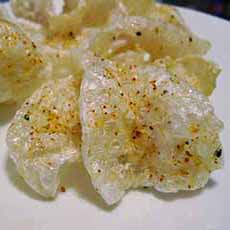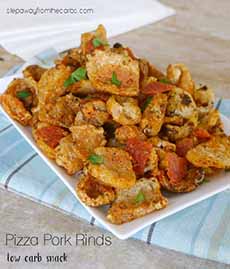FOOD FUN: Make Pork Rinds For National Pork Rinds Day
|
Super Bowl Sunday is Pork Rinds Day, a no-carb, Keto, Paleo snack. And a beloved snack before anyone ever heard of Paleo and Keto diets*. Pork rinds (chicharrónes, the Spanish word) are made from pork skin, with the attached fat removed and deep-fried. That’s the difference between pork rinds and pork cracklings. Cracklings include the fat that adheres to the skin. Because of the extra fat, cracklings are greasier, denser, and a bit chewy. In comparison, pork rinds are airy like cheese puffs, and they dissolve in your mouth. The fat is seasoned or marinated before frying; pork skins are often dehydrated. Fried pork rinds/chicharrones are popular in various cuisines, including Latin American, Filipino, Mexican, and Spanish. Fried skin is also prepared from other animals, including beef, chicken, fish (think of salmon skin sushi), and mutton. > The different cuts of pork. In the U.S., fried pork rinds are most often served as a crunchy snack, in the manner of potato chips. Like potato chips, manufacturers of pork rinds flavor them in every which way, from international flavors to bacon and beer. Contemporary pork-rind-loving chefs began to use it as a garnish, for burgers, salads and other dishes. Each country has its own style of serving fried pork rinds. For example: *Paleo eliminates grains, legumes, processed sugar and most sources of dairy, eating a “caveman” diet before processed foods. The Keto diet aims to put the body into ketosis, a metabolic state in which the body uses calories from fat, instead of carbs, to create the energy needed to carry out its normal functions. Here’s more about it. †Yuca (YOO-cuh) is the root portion of the cassava plant. Yucca, on the other hand, is an ornamental plant, not the same as yuca. While they are both members of the Angiosperms clade (near the top of the binomial chart), they diverge at that point: |
|
|
|
Yuca: Kingdom Plantae, Clade Tracheophytes, Clade Angiosperms, (they diverge here) Clade Monocots, Order Asparagales, Family Asparagaceae, Subfamily Agavoideae, Genus Yucca, Species [various]. Yucca: Kingdom Plantae, Clade Tracheophytes, Clade Angiosperms, (they diverge here) Clade Eudicots, Clade Rosids, Order Malpighiales, Family Euphorbiaceae; Genus Manihot, Species esculenta [source: Wikipedia]. CHECK OUT WHAT’S HAPPENING ON OUR HOME PAGE, THENIBBLE.COM. |
||






